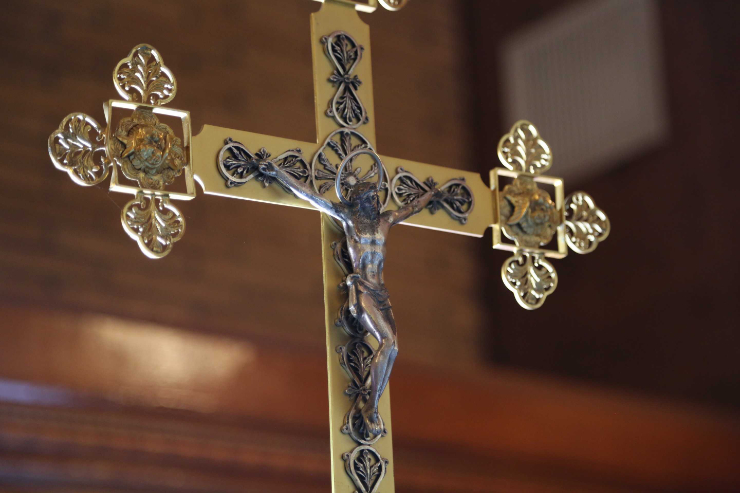On Ash Wednesday, the minister marks the cross on our foreheads with ashes and says, “Remember, you are dust and to dust you will return.” It is a reminder that we are human, that in death our bodies will remain on the earth and decay while the souls of the just will go to meet God and wait to be reunited with the glorified body through the power of Jesus’ Resurrection. We believe this glorious spiritual truth in faith. Scientifically, we know the body decays too. We can see it happen, a process by which the complexly structured living body decomposes back to simpler and simpler molecules until it is but—dust.
The chemical origin of life is harder for us to understand. Genesis 2:7 says, “And the Lord God formed man out of the slime of the earth and breathed into his face the breath of life, and man became a living soul.” The biblical statement that “God formed man out of the slime of the earth” is consistent with the idea that we were formed from non-living material. Scientists have studied the process of chemical evolution, and they consider the origin of life a hypothesis subject to experimental verification.
Scientific Discoveries About the Origin of Life
Until 1668, natural scientists thought life spontaneously generated from nonliving material because decaying meat produced maggots, mud produced fish, and grain produced mice. Spontaneous generation was a reasonable explanation for what people observed.
In 1668, an Italian physician, Francesco Redi, disproved spontaneous generation by putting decaying meat in both covered and open jars. The maggots did not appear, of course, in the former but they did appear in the latter. Still, people thought spontaneous generation may occur from a “vital force” in the air.
In the mid-1800s, Louis Pasteur disproved the spontaneous generation of microorganisms from air. In his experiments, he boiled a nutrient-rich broth to kill all microorganisms. When he allowed air into the broth, no microorganisms were produced, but when he added other microorganisms into the boiled broth, more microorganisms soon grew.
The conclusion, as we well know today, is that living organisms come from other living organisms. Living organisms do not spontaneously appear from nonliving material. This is the cornerstone of biology, the reason why the theory of evolution is foundational to all biological sciences. Evolution fundamentally depends on “biogenesis,” the generation of organisms from other organisms.
Although biologists have accepted the concept of biogenesis for well over 150 years, the experiments above shed no light on how life arose in the first place. There have been other experiments to explore the question of “abiogenesis,” the chemical evolution of the origin of life from non-living material.
In 1871, Charles Darwin was one of the first scientists to advance a hypothesis about abiogenesis. Darwin is also known as the originator of the theory of evolution. In a letter to a colleague he wrote:
It is often said that all the conditions for the first production of a living organism are now present, which could ever have been present. But if (and oh what a big if) we could conceive in some warm little pond, with all sorts of ammonia and phosphoric salts, light, heat, electricity, etc., present, that a protein compound was chemically formed ready to undergo still more complex changes, at the present day such matter would be instantly devoured, or absorbed, which would not have been the case before living creatures were formed.
Since Darwin’s time, radioactive dating studies indicate that the earth is about 4.6 billion years old. The fossil record indicates that earliest evidence of life, organisms resembling modern day bacteria, originated about 3.5 billion years ago. Thus, data indicate there was a time of about a billion years when no life existed on earth, a “prebiotic era” in scientific terms.
There have been many experiments to probe the steps of this primal abiogenesis, and the studies are ongoing. Any summary found in textbooks of the history of these developments is prefaced with the statement that scientists readily acknowledge it is impossible to determine exactly how life arose on earth. Scientists form theories about how a living cell might have arisen through a series of steps, with each step having some probability of occurring. Simple carbon-containing molecules must have formed. Then those molecules must have organized into complex polymers and then into three-dimensional proteins, carbohydrates, and nucleic acids essential for life.
Scientists hypothesize there must have been little or no free oxygen because free oxygen would not have been in the atmosphere before the existence of photosynthesizing cells and because an organic compound spontaneously synthesized in the presence of free oxygen would have instantly degraded. The primitive atmosphere might have had water vapor, carbon dioxide, nitrogen, methane, and ammonia.
In the 1930s, a Russian scientist, Alexander Oparin, hypothesized that life began in the oceans, with the sun, lightning, and heat triggering chemical reactions to produce small organic molecules from substances in the air. Then rain, he suggested, might have washed the molecules into the oceans to form the “primordial soup.”
In 1949, a British molecular biologist, John Desmond Bernal, hypothesized that life arose in roughly three stages: 1) a chemical evolution from simple molecules found in rocks, water, and air to biological monomers, 2) the organization of these monomers into biological polymers, and 3) the organization of these polymers into structures such as proteins and cells. There might have been first a “chemical evolution” to the first cell and then a “biological evolution” from a first living cell to the biodiversity we find today known as the “web of life.”
In 1953, two American scientists, Stanley Miller and Harold Urey, simulated Oparin’s hypothesis in the laboratory. They mixed water vapor with ammonia, methane, and hydrogen gases. Then they sent an electric current through the mixture (lightning). Then they cooled the mixture (rain) and collected it in a flask. After a week, they found several kinds of amino acids, sugars, and other small organic molecules such as those found in living things. In the 1950’s more experiments were done to show that if amino acids are heated in the absence of oxygen, they can form proteins.
In 1965, another American biochemist, Sidney Fox, showed that heating solutions of amino acids produces short chains of amino acids which then organize into large, ordered structures with a membrane that can carry out some life activities, such as growth and division. He called this structure a “protocell.”
But Science is Never Complete
In spite of these experiments, there is still no “standard model” of the origin of life. No one has actually synthesized a “protocell” from the “bottom up.” Some researchers, such as Steen Rasmussen, a Danish physicist, and Jack Szostak, a Canadian American geneticist, are exploring whether a “top-down approach” is a better explanation. They study existing organisms to discern what the minimal requirements are for life. Their research, therefore, involves the study of the production of “artificial life.” Still others, such as Romanian-American ecologist John Priscu, study whether life originated in hot or cold environments or both independently.
Fundamental to all these scientific studies is the view that living things differ from non-living things primarily in their degree of organization, but the question still remains whether all the properties of biological life can be explained by complex organization. Life itself, even considered in strictly scientific terms, still points to something beyond it. One might wonder whether these scientific speculations through history are in conflict with Christian beliefs? No, they are not. These theories propose a gradual evolution of life based on the chemical properties of matter favored by (i.e. naturally selected by) the primitive earth’s environment.
Scripture says that God created all things, living and non-living, spiritual and material. If living organisms arose from non-living material because their organization reached a certain necessary complexity for the vital activities of growth and reproduction, this transition can be regarded as a result of the potentialities the Creator endowed. Fr. Jean Buridan posited in the mid-1300s that God could have created both terrestrial and celestial bodies with physical laws that kept them in motion, an intellectual breakthrough guided by faith that led to the emergence of modern science. This kind of thinking is neither new to the Church nor to science.
A Lenten Challenge
The purpose for presenting a brief summary of the scientific developments regarding the origin of life on Ash Wednesday is to hopefully inspire a deeper consideration of science in the light of faith.
Many Christians are hesitant to accept the theory of either the chemical evolution of abiogenesis or the biological evolution of the diversity of life. Yet the Church has not rejected evolutionary theory. Current theological developments do not reject evolutionary theory. The Pontifical Academy of Sciences for decades has actively engaged the scientific community about evolution, among other difficult topics.
The hesitation is understandable though because the meaning of “accepting evolution” is not clear. People of deep faith and devotion are confused by the ambiguous controversies and complicated details of abiogenesis and evolutionary theory. They rightly wonder if to “accept evolution” is to accept something contrary to the tenets of Christian faith. Scientific knowledge, after all, is not what gets people to Heaven.
But I do not recommend dismissing the science. Science is the study of God’s Handiwork. The brief history presented above can be found in any high school or college biology textbook. Scientists, in general, do not spend their hours conjuring up ideas to dismiss God. They formulate hypotheses to understand how the world works, and in this case to understand how the very real immaterial aspect of our life developed.
If you guide another, there is actually a danger in dismissing misunderstood science. For example, if a parent teaches a child a strictly literal account of Creation word-for-word in Genesis out of fear that scientific progress will marginalize God, that child is primed for sure confusion if he or she ever opens a biology textbook. Is it a surprise when young adults reject their unchallenged religious beliefs upon attending college biology class?
So, on this Ash Wednesday when we are reminded in black symbol marked upon our foreheads of the unity of our materialism and our spiritualism, perhaps it is a good time to reflect on that uniquely human activity we call science. We are discursive creatures, lower than angels because we have bodies and higher than animals because we have intellects and free will. Hence, the scientific method is a necessity in two ways. First, it is a necessity because we cannot obtain knowledge at once. We must go in steps, gaining sense knowledge before we synthesize abstract knowledge, continuing in the cycle of hypothesizing, collecting data, and analyzing. Second, the scientific method is a necessity because humans, made in the image of God as stated in Genesis 1:27, are inherently meant to delve into mystery, to learn, discover, and search for truth beyond themselves. We cannot stop asking questions about our world, our origins, or our destiny.
The statement—“You are dust and to dust you will return”—has a scientific meaning but one only understood in the light of faith. This statement shows us how to approach scientific questions about the meaning and purpose of our existence. We do not need to be hesitant about learning science if we remember that 1) faith illuminates science, and 2) science is never complete, as the history of scientific ideas about the chemical origin of life aptly demonstrates.














